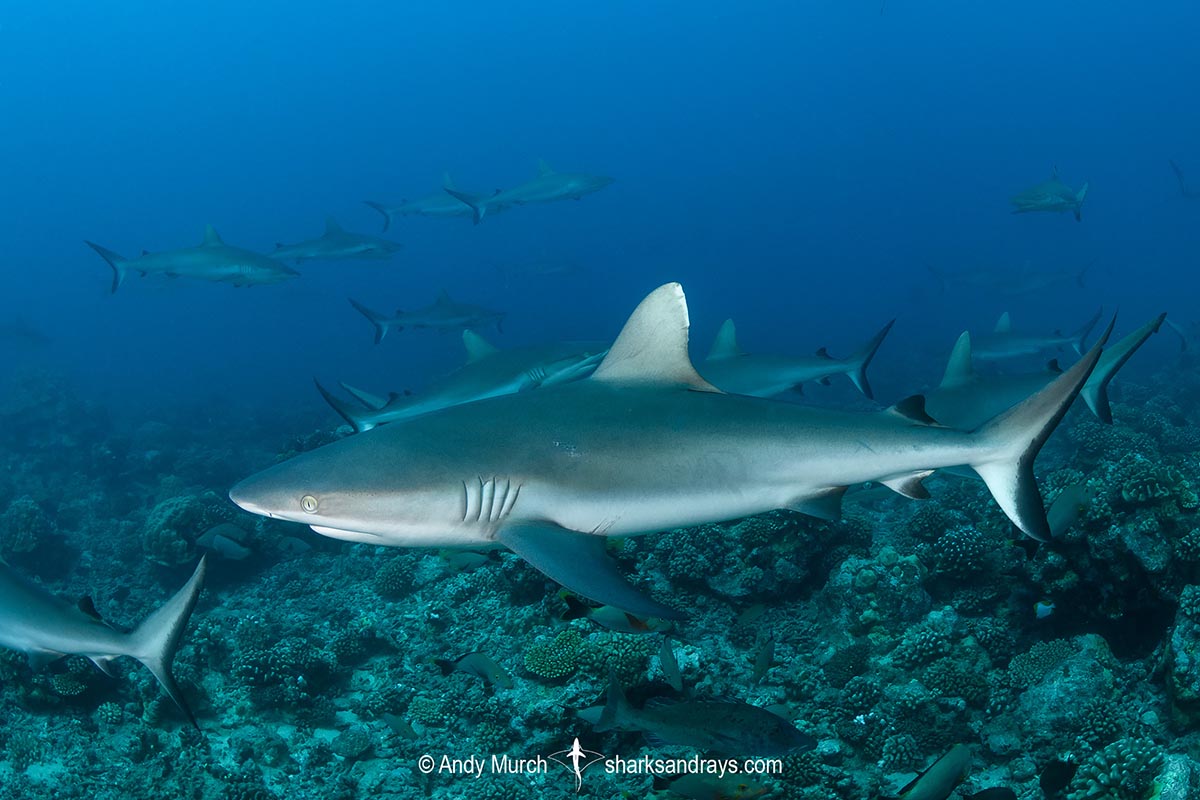Common names
Grey Reef Shark, Reef Shark, Grey Whaler.
Binomial
Carcharhinus amblyrhynchos
Synonyms
Carcharhinus wheeleri, Carcharias amblyrhynchos, Carcharias nesiotes,Galeolamna coongoola, Galeolamna fowleri, Galeolamna tufiensis.
Identification
First dorsal fin origin slightly anterior of pectoral fin rear tip. Dorsal colouration grey or brownish-grey. White ventrally with dusky or black fin tips. Colour of fins variable. First dorsal usually plain grey, sometimes with a thin white posterior margin (similar to a silvertip shark). Pectoral fins grey, often with dusky rear margins. Pelvic fins often dusky. Second dorsal and anal fin either dusky or with a black posterior margin. Upper and lower caudal lobes have a wide black trailing edge; the defining characteristic of this species.
Size
Maximum length possibly 255cm (unconfirmed) but usually much smaller. Age at maturity of males/females 130-145cm/120-142cm.

Conservation Status
ENDANGERED
The Grey Reef Shark (Carcharhinus amblyrhynchos) is heavily targeted and caught as bycatch throughout much of its range. It is often retained for its fins, flesh, skin, teeth and liver. Grey reef sharks have also been impacted by reef degeneration due to climate change, dynamite fishing, and run off.
Although major declines have been reported in some areas, grey reef sharks are still locally abundant in areas where they are protected such as in French Polynesia. Carcharhinus amblyrhynchos is estimated to have declined by 50–79% in the last three generation lengths (44 years).

Habitat
Tropical reefs, atoll passes and lagoons, inshore or along deep oceanic drop-offs.
Distribution
The grey reef shark is a widespread in the tropical Indian Ocean and West/Central Pacific. Rarely (if ever) encountered in Eastern Pacific.
Reproduction
A viviparous species with yolk-sac placenta. 1-6 pups per litter.
Gestation approximately 12 months.
Diet
Diet consists mainly of small bony reef fishes. Also preys on cephalopods and crustaceans.
Behavior
The grey reef shark is a highly social species that is often seen in large polarized groups swimming slowly ‘upstream’ in current swept passes of atolls or reef channels by day. At night individuals leave the group to hunt alone on nearby reefs and drop-offs.
Grey reefs show a high degree of site fidelity, sometimes venturing quite far offshore but always returning to the same spot to rest. In some areas, they mat undergo migrations; perhaps in search of food or to mate. One individual tagged at a remote island in the Coral Sea traveled 250km to the Great Barrier Reef and back.
When threatened, grey reefs sharks perform an agonistic threat display by lowering their pectoral fins, arching their backs and swimming in an exaggerated manner.
Reaction to divers
Quite easy to approach with non-threatening movements; especially where they are habituated to the presence of divers.
Diving logistics
Although their numbers have declined, grey reef sharks are still abundant in many areas too numerous to list here.
Perhaps the most spectacular place to encounter them is in the south pass of Fakarava Atoll in the Tuamotu Archipelago in French Polynesia. At this location, it is possible to descend approximately 12m and hover or rest on the reef rubble at the side of the pass to watch the show. On a good day, it is not unreasonable to see 300-400 grey reef sharks swimming slowly up-current through the pass. Being nocturnal hunters, this is their rest period during which they do very little other than keeping pace with the rest of the school. Once they make it to the end of the pass where the current diminishes, they simply peel off and quickly swim downstream to the beginning of the pass and fall back into formation.
Occasionally a reef fish will catch a shark’s interest and then all of the surrounding sharks will zip in to see if there is anything to eat, but they soon return to their slow progression up current.
Mixed in with the grey reefs there are usually a few silvertips and one or two shy oceanic blacktips. Down on the floor of the channel, you can usually spot 20-30 whitetip reef sharks resting on the bottom, facing into the curreent to help them breathe. If the current isn’t too strong at the end of the dive, it is possible to drift into a shallow spot where blacktip reef sharks hang out; hoping for scraps from fishermen.
The entire atoll is a UNESCO World Heritage Site and heavily protect from any form of fishing so the reef is extremely abundant and very few of the sharks have hooks or hook scars. Fakarava is unquestionably one of the best places in the world to encounter large numbers of reef sharks.
Similar species
Blacktip Shark Distinguished by a longer, more laterally depressed, pointed snout and lack of black margin on upper caudal lobe.













